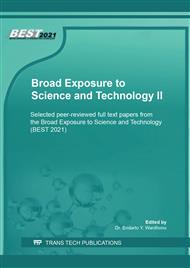[1]
Q. Ren, M. Wu, Z. Weng, X. Zhu, W. Li, P. Huang, L. Wang, W. Zheng, M. Ohshima, Promoted formation of stereocomplex in enantiomeric poly(lactic acid)s induced by cellulose nanofibers. Carbohydr. Polym. 276 (2022).
DOI: 10.1016/j.carbpol.2021.118800
Google Scholar
[2]
C. Xu, J. Chen, D. Wu, Y. Chen, Q. Lv, and M. Wang, Polylactide/acetylated nanocrystalline cellulose composites prepared by a continuous route: A phase interface-property relation study. Carbohydr. Polym. 146 (2016) 58–66.
DOI: 10.1016/j.carbpol.2016.03.058
Google Scholar
[3]
H. Wu, S. Nagarajan, J. Shu, T. Zhang. L. Zhou Y. Duan, J. Zhang, Green and facile surface modification of cellulose nanocrystal as the route to produce poly(lactic acid) nanocomposites with improved properties. Carbohydr. Polym. 197 (2018) 204–214.
DOI: 10.1016/j.carbpol.2018.05.087
Google Scholar
[4]
X. Zhao, J. Li, J. Liu, W. Zhou, and S. Peng, Recent progress of preparation of branched poly(lactic acid) and its application in the modification of polylactic acid materials. International Journal of Biological Macromolecules. 193 (2021) 874–892.
DOI: 10.1016/j.ijbiomac.2021.10.154
Google Scholar
[5]
T. Maharana, B. Mohanty, and Y. S. Negi, Melt-solid polycondensation of lactic acid and its biodegradability. Progress in Polymer Science (Oxford). 34 (2009) 99–124.
DOI: 10.1016/j.progpolymsci.2008.10.001
Google Scholar
[6]
T. L. de Albuquerque, J. E. Marques Júnior, L. P. de Queiroz, A. D. S. Ricardo, and M. V. P. Rocha, Polylactic acid production from biotechnological routes: A review. International Journal of Biological Macromolecules. 186 (2021) 933–951.
DOI: 10.1016/j.ijbiomac.2021.07.074
Google Scholar
[7]
T. Kitanosono and S. Kobayashi, Water-compatible Chiral Lewis Acids, in Chiral Lewis Acids in Organic Synthesis. J. Mlynarski, Ed. Wiley-VCH Verlag GmbH & Co. KGaA, 1 (2017) 299–344.
DOI: 10.1002/9783527802142.ch9
Google Scholar
[8]
K. Pradhan, S. Paul, and A. R. Das, Fe(DS)3, an efficient Lewis acid-surfactant-combined catalyst (LASC) for the one pot synthesis of chromeno[4,3-b]chromene derivatives by assembling the basic building blocks. Tetrahedron Lett. 54 (2013) 3105–3110.
DOI: 10.1016/j.tetlet.2013.04.001
Google Scholar
[9]
H. Firouzabadi, N. Iranpoor, and A. Khoshnood, Aluminum tris (dodecyl sulfate) trihydrate Al(DS)3·3H2O as an efficient Lewis acid-surfactant-combined catalyst for organic reactions in water. Efficient conversion of epoxides to thiiranes and to amino alcohols at room temperature. J. Mol. Catal. A Chem. 274 (2007) 109–115.
DOI: 10.1016/j.molcata.2007.04.035
Google Scholar
[10]
H. R. Safaei, M. Shekouhy, S. Khademi, V. Rahmanian, and M. Safaei, Diversity-oriented synthesis of quinazoline derivatives using zirconium tetrakis(dodecylsulfate) [Zr(DS)4] as a reusable Lewis acid-surfactant-combined catalyst in tap water. J. Ind. Eng. Chem. 20 (2014) 3019–3024.
DOI: 10.1016/j.jiec.2013.11.037
Google Scholar
[11]
L. S. Chafran, M. F. Paiva, J. O. C. Freitas, M. J. A. Sales, S. C. L. Dias, and J. A. Dias, Preparation of PLA blends by polycondensation of D,L-lactic acid using supported 12-tungstophosphoric acid as a heterogeneous catalyst. Heliyon. 5 (2019).
DOI: 10.1016/j.heliyon.2019.e01810
Google Scholar
[12]
M. Machida, K. Kawamura, T. Kawano, D. Zhang, and K. Ikeue, Layered Pr-dodecyl sulfate mesophases as precursors of Pr2O2SO4 having a large oxygen-storage capacity. J. Mater. Chem. 16 (2006) 3084–3090.
DOI: 10.1039/b605518d
Google Scholar
[13]
K. Nakamoto, Applications in Inorganic Chemistry. Infrared and Raman Spectra of Inorganic and Coordination Compounds. (2008) 149–354.
DOI: 10.1002/9780470405840.ch2
Google Scholar
[14]
G. F. Ghesti, J. L. de Macedo, V. C. I. Parente, J. A. Dias, and S. C. L. Dias, Synthesis, characterization and reactivity of Lewis acid/surfactant cerium trisdodecylsulfate catalyst for transesterification and esterification reactions. Appl. Catal. A Gen. 355 (2009) 139–147.
DOI: 10.1016/j.apcata.2008.12.008
Google Scholar
[15]
L. A. Smith, R. B. Hammond, K. J. Roberts, D. Machin, and G. McLeod, Determination of the crystal structure of anhydrous sodium dodecyl sulphate using a combination of synchrotron radiation powder diffraction and molecular modelling techniques, J. Mol. Struct. 554 (2000) 173–182.
DOI: 10.1016/s0022-2860(00)00666-9
Google Scholar
[16]
L. Sicard, P. L. Llewellyn, J. Patarin, and F. Kolenda, Investigation of the mechanism of the surfactant removal from a mesoporous alumina prepared in the presence of sodium dodecylsulfate. Microporous Mesoporous Mater. 44–45 (2001) 195–201.
DOI: 10.1016/s1387-1811(01)00184-6
Google Scholar
[17]
S. Shirakawa and S. Kobayashi, Surfactant-Type Brønsted Acid Catalyzed Dehydrative Nucleophilic Substitutions of Alcohols in Water, Org. Lett. 9 (2007) 311–314.
DOI: 10.1021/ol062813j
Google Scholar


